My first Mass CUE experience was quite an eye-opener. I wasn’t entirely sure what to expect, but I certainly didn’t anticipate walking into a scene that was reminiscent of my days as a recruiter for Southern New Hampshire University. It reminded me of the time I had the opportunity to represent SNHU at the International Hotel, Motel, and Restaurant Show held annually at the Jacob K. Javits Center in Manhattan. I knew there would be a vendor showcase at Mass CUE, however I didn’t realize the magnitude of educational technology companies that would be on hand offering demos, free giveaways and overviews of the hottest tech gadgets and gizmos. To be honest, I passed by every flashy booth because I was on a mission. I was there to showcase something different. I attended Mass CUE because I had the opportunity to promote my students and their involvement in the Burlington High School Student Technology Integration Program, a.k.a. the BHS Help Desk: A Student Run Genius Bar.
Help Desk: Years One and Two
Help Desk was developed two years ago by the BPS Ed Tech Team, led by the Burlington Public Schools Director of Technology Integration Dennis Villano, in an effort to support the district’s 1:1 iPad initiative. Since its inception, it has become a model program for many schools across the country, if not the world, that are also interested in developing student run technology support programs.
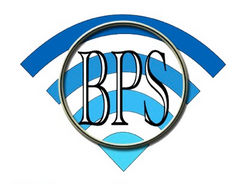 Over the past two years, the primary focus of Help Desk students has been assisting and supporting the IT and Ed Tech departments throughout the district with the deployment of 1:1 essentials including iTunes and Apple ID’s, installation of apps, iOS updates, student Gmail accounts, enrolling devices into our mobile device management system, and supporting the transition to a Google Apps For Education school. Graduates of the Help Desk program are so valuable to the district that they were actually hired over the summer to continue working with the ed tech team and prepare for year three of the 1:1 initiative. Currently, the district is 1:1 at grades 1 and 4-12. By year four, Burlington plans to be a K-12 1:1 iPad district. And while two years hardly constitutes an “old” program, the great thing about Burlington, and why I love being a part of the team, is the fast pace at which the district moves. Burlington is always looking forward and we owe that to our students.
Over the past two years, the primary focus of Help Desk students has been assisting and supporting the IT and Ed Tech departments throughout the district with the deployment of 1:1 essentials including iTunes and Apple ID’s, installation of apps, iOS updates, student Gmail accounts, enrolling devices into our mobile device management system, and supporting the transition to a Google Apps For Education school. Graduates of the Help Desk program are so valuable to the district that they were actually hired over the summer to continue working with the ed tech team and prepare for year three of the 1:1 initiative. Currently, the district is 1:1 at grades 1 and 4-12. By year four, Burlington plans to be a K-12 1:1 iPad district. And while two years hardly constitutes an “old” program, the great thing about Burlington, and why I love being a part of the team, is the fast pace at which the district moves. Burlington is always looking forward and we owe that to our students.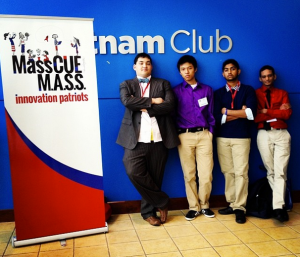 The purpose of Help Desk students presenting at this year’s Mass CUE was to provide attendees with an overview of how the BHS program is structured (see thecourse syllabus) and offer advice and strategies on how to go about launching something similar. As with all technology integration initiatives, nothing is one size fits all, nor should it be, and student run “genius bars,” or whatever name you decide to adopt for your program, are no exception. School culture, student enrollment, personnel, curriculum, budget, faculty support, administrative philosophy, and infrastructure are just a few of the variables that may influence the development and sustainability of a student run technology support team. Additionally, the number and types of devices being deployed in a school or district is also a major factor to consider. However, I would argue that the most important factor in launching a student run help desk would be the process of identifying, screening, training and promoting the students involved in the program. For those of you who missed our presentation, or did not attend Mass CUE, this post has been designed to answer questions and provide ideas on how to go about designing your own Help Desk program.
The purpose of Help Desk students presenting at this year’s Mass CUE was to provide attendees with an overview of how the BHS program is structured (see thecourse syllabus) and offer advice and strategies on how to go about launching something similar. As with all technology integration initiatives, nothing is one size fits all, nor should it be, and student run “genius bars,” or whatever name you decide to adopt for your program, are no exception. School culture, student enrollment, personnel, curriculum, budget, faculty support, administrative philosophy, and infrastructure are just a few of the variables that may influence the development and sustainability of a student run technology support team. Additionally, the number and types of devices being deployed in a school or district is also a major factor to consider. However, I would argue that the most important factor in launching a student run help desk would be the process of identifying, screening, training and promoting the students involved in the program. For those of you who missed our presentation, or did not attend Mass CUE, this post has been designed to answer questions and provide ideas on how to go about designing your own Help Desk program.Becoming a Genius:
In Burlington, although Help Desk is an elective listed in our school’s course catalog, students must apply in order to be admitted into the program. 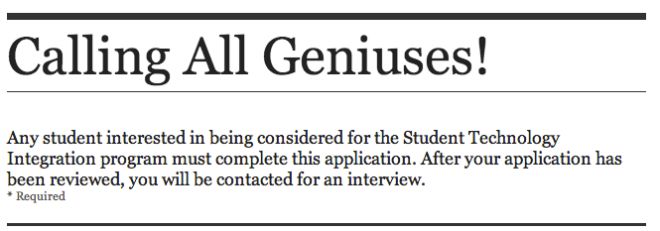 After the initial application, which can be seen here, students are invited to interview with members of the Ed Tech Team. This screening process helps to determine potential STARS: Students with the appropriate academic background, technology skills and professionalism to be a part of areal-world learning opportunity. A structured interview process can help your program be asuccess. An important point to remember is that it’s not about the quantity of students in the program, it’s about the quality. A small team of knowledgable, eager, and hard-working students who are in the program for the right reasons can be much more effective than a large team of students who may enjoy using technology, but are not necessarily suited to assist with the tech integration needs of your school community. The goal is to create asuccessful team of students who are willing to work hard and deserve the title “genius.” A note about STARS… In my previous school, as a member of the Pinkerton Academy Career & Technical Education Department, I developed a formal STARS program where each CTE program identified two students who served as ambassadors at various CTE events. The program was a huge success and continues to be a major component of the CTE’s recruiting strategy. Every school has STARS and I think this program can be adapted to any school environment, thus I am highlighting the Help Desk STARS of 2013-2014.
After the initial application, which can be seen here, students are invited to interview with members of the Ed Tech Team. This screening process helps to determine potential STARS: Students with the appropriate academic background, technology skills and professionalism to be a part of areal-world learning opportunity. A structured interview process can help your program be asuccess. An important point to remember is that it’s not about the quantity of students in the program, it’s about the quality. A small team of knowledgable, eager, and hard-working students who are in the program for the right reasons can be much more effective than a large team of students who may enjoy using technology, but are not necessarily suited to assist with the tech integration needs of your school community. The goal is to create asuccessful team of students who are willing to work hard and deserve the title “genius.” A note about STARS… In my previous school, as a member of the Pinkerton Academy Career & Technical Education Department, I developed a formal STARS program where each CTE program identified two students who served as ambassadors at various CTE events. The program was a huge success and continues to be a major component of the CTE’s recruiting strategy. Every school has STARS and I think this program can be adapted to any school environment, thus I am highlighting the Help Desk STARS of 2013-2014.
 After the initial application, which can be seen here, students are invited to interview with members of the Ed Tech Team. This screening process helps to determine potential STARS: Students with the appropriate academic background, technology skills and professionalism to be a part of areal-world learning opportunity. A structured interview process can help your program be asuccess. An important point to remember is that it’s not about the quantity of students in the program, it’s about the quality. A small team of knowledgable, eager, and hard-working students who are in the program for the right reasons can be much more effective than a large team of students who may enjoy using technology, but are not necessarily suited to assist with the tech integration needs of your school community. The goal is to create asuccessful team of students who are willing to work hard and deserve the title “genius.” A note about STARS… In my previous school, as a member of the Pinkerton Academy Career & Technical Education Department, I developed a formal STARS program where each CTE program identified two students who served as ambassadors at various CTE events. The program was a huge success and continues to be a major component of the CTE’s recruiting strategy. Every school has STARS and I think this program can be adapted to any school environment, thus I am highlighting the Help Desk STARS of 2013-2014.
After the initial application, which can be seen here, students are invited to interview with members of the Ed Tech Team. This screening process helps to determine potential STARS: Students with the appropriate academic background, technology skills and professionalism to be a part of areal-world learning opportunity. A structured interview process can help your program be asuccess. An important point to remember is that it’s not about the quantity of students in the program, it’s about the quality. A small team of knowledgable, eager, and hard-working students who are in the program for the right reasons can be much more effective than a large team of students who may enjoy using technology, but are not necessarily suited to assist with the tech integration needs of your school community. The goal is to create asuccessful team of students who are willing to work hard and deserve the title “genius.” A note about STARS… In my previous school, as a member of the Pinkerton Academy Career & Technical Education Department, I developed a formal STARS program where each CTE program identified two students who served as ambassadors at various CTE events. The program was a huge success and continues to be a major component of the CTE’s recruiting strategy. Every school has STARS and I think this program can be adapted to any school environment, thus I am highlighting the Help Desk STARS of 2013-2014.Skills:
When developing your help desk program, consider the prerequisite skills students must possess. At BHS, Help Desk students are not only called upon to provide hands-on technical assistance to students and teachers with devices and applications, they are also required to make meaningful contributions to the Help Desk blog. This means students must have strong research, writing, and collaboration skills. BHS Help Desk students begin blog posts in a Google Doc that is shared with me. Once the post has been edited and revised, it can then be published on the blog. I’ve been working with my students to help them author posts that demonstrate superior writing skills, and I use my background in marketing education to help them focus on reaching a specific target market, typically either students, teachers, or parents. I’ve also been encouraging them to think about the aesthetics of their post and how their published work will look on multiple devices. While the content of the post is the top priority, I also feel strongly that teaching students how to design a post with the use of images, videos, and links is also essential. There’s nothing more rewarding than seeing a student’s face light up when he realizes his post views have hit triple, or even quadruple digits (happened last year, it can happen again!). Providing students with ablogging rubric can help them clearly understand your expectations and help guide them towards developing mastery in the skill areas you have identified. And since the internet has become a place where everyone can contribute, it just makes sense that you give your students the opportunity to add ” author” to the experience section of their resumes and showcase their work through their own digital portfolio.
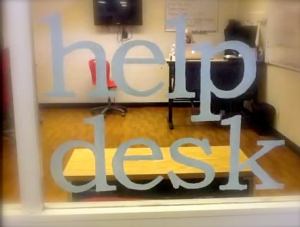 If your school’s infrastructure is in tact, hardware is functioning properly, and technology is being used to establish a digital workflow, then it’s possible your Help Desk may experience “slow” times. This is actually the ideal situation, because it allows your students to think critically and creatively about the role of technology in an educational setting. Students can focus on exploring new and exciting technology that can solve problems and positively impact teaching and learning in all content areas. I definitely want my students to pursue their own tech interests and curiosity when writing their posts, this is part of their learning process, but I’ve discovered that students do need guidance and suggestions on what to research. I’ve encouraged students to think about what is going on in their classes and have pointed them towards educational blogs and other credible resources for ideas and inspiration. You may want to think about having your students conduct primary research to discover the attitudes, beliefs, and opinions of the stakeholders in your district on a variety of educational technology trends. For example, two of my students collaborated on developing a survey about iOS6 versus iOS7 and will be analyzing and reporting on the results of their survey via a blog post. Several weeks ago, two of my students experienced life as a BHS student with a Chromebook instead of an iPad and authored a post about their experience which has been view 621 times as of today and a recent Notability post was viewed 130 times. The ultimate goal is to have students become innovative, self-directed learners who can:
If your school’s infrastructure is in tact, hardware is functioning properly, and technology is being used to establish a digital workflow, then it’s possible your Help Desk may experience “slow” times. This is actually the ideal situation, because it allows your students to think critically and creatively about the role of technology in an educational setting. Students can focus on exploring new and exciting technology that can solve problems and positively impact teaching and learning in all content areas. I definitely want my students to pursue their own tech interests and curiosity when writing their posts, this is part of their learning process, but I’ve discovered that students do need guidance and suggestions on what to research. I’ve encouraged students to think about what is going on in their classes and have pointed them towards educational blogs and other credible resources for ideas and inspiration. You may want to think about having your students conduct primary research to discover the attitudes, beliefs, and opinions of the stakeholders in your district on a variety of educational technology trends. For example, two of my students collaborated on developing a survey about iOS6 versus iOS7 and will be analyzing and reporting on the results of their survey via a blog post. Several weeks ago, two of my students experienced life as a BHS student with a Chromebook instead of an iPad and authored a post about their experience which has been view 621 times as of today and a recent Notability post was viewed 130 times. The ultimate goal is to have students become innovative, self-directed learners who can:
1. Research an education technology tool
2. Analyze and evaluate its appropriateness in an educational setting
3. Make a suggestion as to how it could be used in the classroom in variety of content areas
4. Demonstrate its use by creating an actual product with the tool
5. Share their creation with teachers and students
2. Analyze and evaluate its appropriateness in an educational setting
3. Make a suggestion as to how it could be used in the classroom in variety of content areas
4. Demonstrate its use by creating an actual product with the tool
5. Share their creation with teachers and students
It takes time to get to this level, but the result is a powerful and authentic learning experience for students. Hopefully, experiences they have created themselves.
Technology: 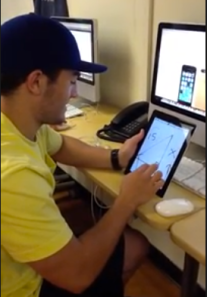
This is a no-brainer. You obviously need students in your program who have a passion for learning and using current technologies. At BHS, teachers have both Macs and PCs, students have iPads and Chromebooks can be signed out from the library. Most of my students feel comfortable working with both platforms and both devices. Students also possess a strong understanding of iOS7 and BHS essentials including Gmail, Google Drive, Dropbox, Evernote, Blogger, Notability, and coming soon, Explain Everything & iMovie. My students have the ability to learn most new technology that is introduced to them, but if they are presented with a problem they can’t solve right away, they are able to research the issue and find an appropriate solution.
Academics:
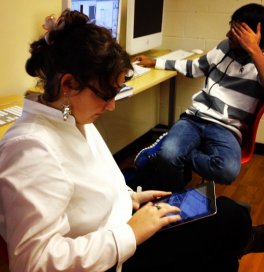 Developing a foundation for your program through designing a course curriculum, clearly defined learning outcomes, and challenging assessments is something you may want to consider. However, I have talked with colleagues who run a program that is a volunteer experience and no academic credit is awarded. The BHS Help Desk curriculum was inspired by Mass CUE keynote speaker Tony Wagner’s seven survival skills. Specifically, to encourage curiosity and imagination, Help Desk students are able to design Individual Learning Endeavors (ILE) which allow them to pursue a personal learning path in virtually any area the student chooses. One day every week, students can invest time into their ILE. This is a new component to Help Desk and is modeled after Google’s twenty percent time project, which is not dead by the way, my former student and current Google employee Michael Westervelt confirmed for me that it’s alive and well. My idea for the ILE experience was also inspired by the program offered Monument Mountain Regional High School in Great Barrington, Massachusetts. Students will present their ILE’s TED Talk style at the end of each semester to members of the BHS administration and IT/Ed Tech team.
Developing a foundation for your program through designing a course curriculum, clearly defined learning outcomes, and challenging assessments is something you may want to consider. However, I have talked with colleagues who run a program that is a volunteer experience and no academic credit is awarded. The BHS Help Desk curriculum was inspired by Mass CUE keynote speaker Tony Wagner’s seven survival skills. Specifically, to encourage curiosity and imagination, Help Desk students are able to design Individual Learning Endeavors (ILE) which allow them to pursue a personal learning path in virtually any area the student chooses. One day every week, students can invest time into their ILE. This is a new component to Help Desk and is modeled after Google’s twenty percent time project, which is not dead by the way, my former student and current Google employee Michael Westervelt confirmed for me that it’s alive and well. My idea for the ILE experience was also inspired by the program offered Monument Mountain Regional High School in Great Barrington, Massachusetts. Students will present their ILE’s TED Talk style at the end of each semester to members of the BHS administration and IT/Ed Tech team.Real-World:
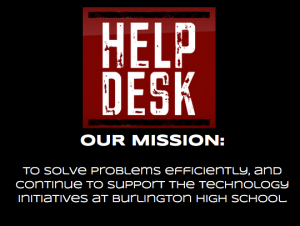 The differentiating factor between a student run help desk and other types of courses is that it offers a real-world learning experience. In an effort to highlight the real-world aspect of the course, students developed a Help Desk mission statement which aligns to themission statement of the high school. This helps to articulate to all district stakeholders what our students do, the value they add to our learning community, and how they go about adding this value. Students also designed a business card and our next goal is to create a commercial to market our services. Students involved in a help desk program gain experience in providing customer service and they become empowered when they realize they are authoring blog posts that are shared with a global audience. If you decide to develop a student run blog as a part of your program, be sure your students know how to view and interpret the site statistics so they understand the impact of what they create. Help Desk students are also able to develop their oral communication skills through delivering presentations at various educational conferences both in and outside of the district.
The differentiating factor between a student run help desk and other types of courses is that it offers a real-world learning experience. In an effort to highlight the real-world aspect of the course, students developed a Help Desk mission statement which aligns to themission statement of the high school. This helps to articulate to all district stakeholders what our students do, the value they add to our learning community, and how they go about adding this value. Students also designed a business card and our next goal is to create a commercial to market our services. Students involved in a help desk program gain experience in providing customer service and they become empowered when they realize they are authoring blog posts that are shared with a global audience. If you decide to develop a student run blog as a part of your program, be sure your students know how to view and interpret the site statistics so they understand the impact of what they create. Help Desk students are also able to develop their oral communication skills through delivering presentations at various educational conferences both in and outside of the district.
Because help desk is a real-world learning opportunity for students, realize you may need to make adjustments to your goals and expectations for a variety of reasons. As you develop your program, be flexible and work with your students to problem solve and develop feasible alternatives. Making adjustments as circumstances and situations arise mirrors the problems faced in business and other industries, and will actually serve as meaningful learning opportunities for both you as a teacher or tech coach and your students. Often times the lessons learned when we fail far exceed what we learn when everything runs according to plan. This is true in any learning environment.
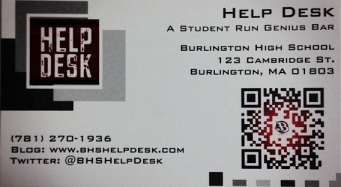
Logistics:
- Help Desk (Student Technology Integration) is a half-credit, one semester course
- Students may take two semesters
- The Help Desk is open 6 out of 7 periods a day
- There are currently 2 – 4 students in the Help Desk every period
- Students are able to visit teachers in their classrooms for one to one assistance
- Students are NOT given network administrator passwords
- Students are able to assist teachers in all content areas throughout the entire district
Help Desk: The Future
I am fortunate to be responsible for ensuring the continued success of the BHS Help Desk program. I am fortunate to work with such a forward thinking group of ed tech professionals who are dedicated to transforming teaching and learning. And I am fortunate to work with such an amazing group of students. Please don’t hesitate to contact me if you would like to discuss our program in even more detail or if you would like to arrange for a visit (in person or virtually) to BHS to talk with the geniuses in person. As you can see from the video below, the students involved in Help Desk are a unique bunch! If you oversee a student run help desk, I would love to learn more about what you are doing in your program, exchange ideas, and perhaps coordinate a meeting so our genius students can learn from one another!

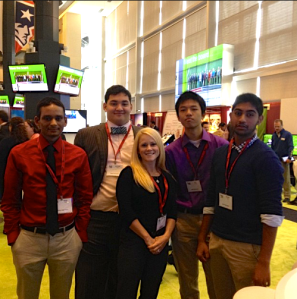
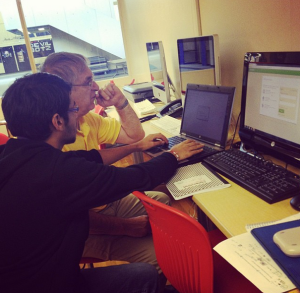
No comments:
Post a Comment